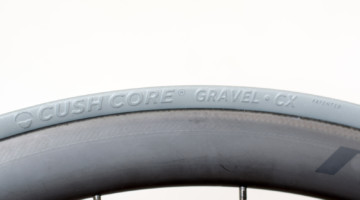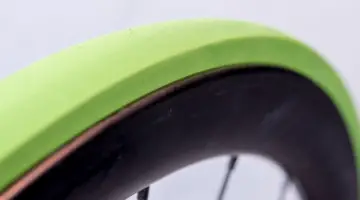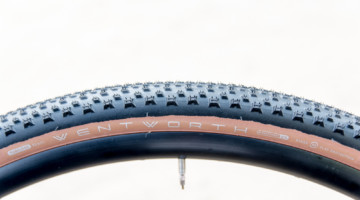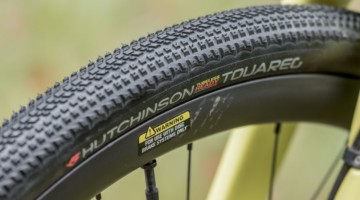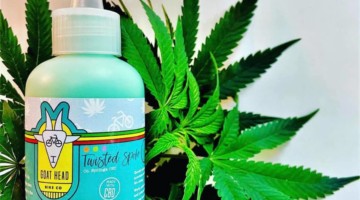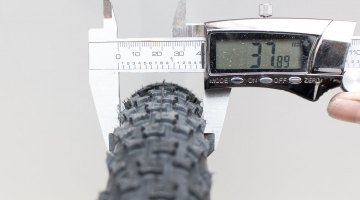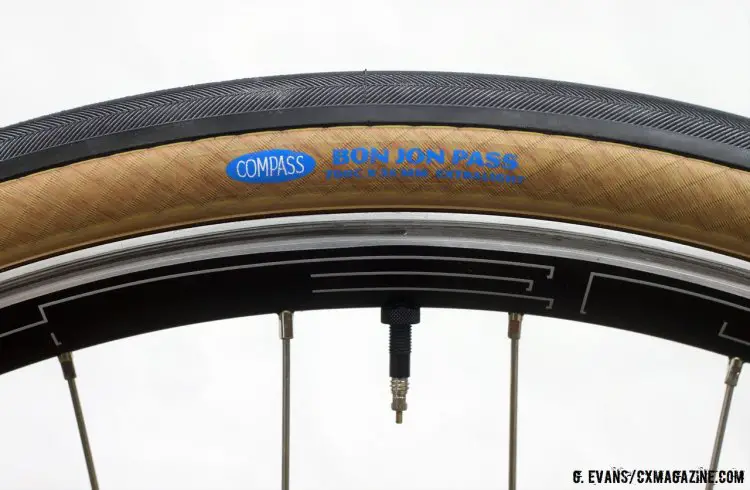
Compass Cycles moves to tubeless with the Bon Jon Pass model (among others), offering a 35c file tread clincher in “Standard” and “Extralight” casing options. © Greg Evans / Cyclocross Magazine
by Greg Evans
Compass tires have, for me, always had a bit of an aura about them. I have always heard–both in and out of Bicycle Quarterly –about the light weight and marshmallow suppleness that their tires offer, and I suppose if anyone is going to know what makes a supple tire, it would be the guy who rode 11 miles on a rumble strip to test the effect that vibrations have on a rider’s wattage output. I was keen to see what all the fuss was about.
As mentioned in our first impressions , the 700x35c Bon Jon Pass Extralight tires weigh just shy of 300 grams; a stat that is certainly nothing to shrug at.
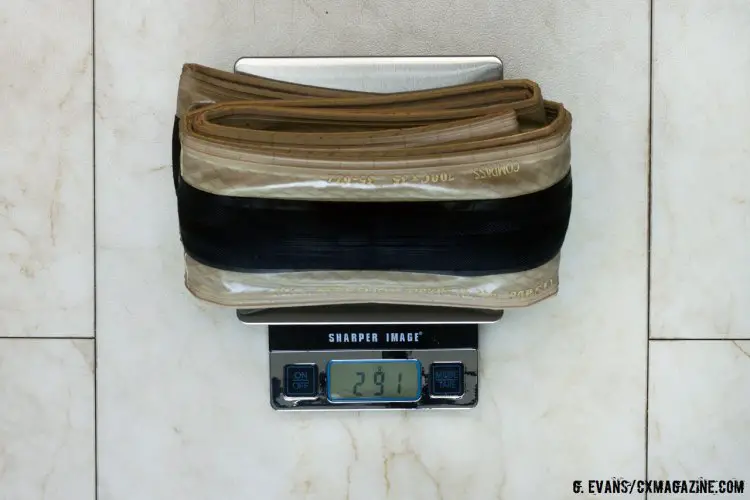
The 700x35c Bon Jon Pass Extralight tire tipped the scale at 291 grams. This number falls below the 303g claimed weight, however the second Bon Jon Pass tire weighed a tad more than the claimed weight at 307 grams. © Greg Evans / Cyclocross Magazine
We also noted the difficulties with setting the tires up on a set of HED Belgium Plus rims. I am happy to report that the tires were much easier to set up on Stan’s Iron Cross rims. However with a maximum rim pressure of 45 psi, this may not be the ideal set up either, as I’ll elaborate on later. I also tried setting them up on a set of American Classic wheels with an internal width of 23.5mm, and they proved to be a bit easier to seal on these rims than the HED wheels as well. Ultimately, of all the wheels that I mounted the tires to, the Compass Bon Jon Pass Extralight 35c tires were never a very tight fit on any rim.
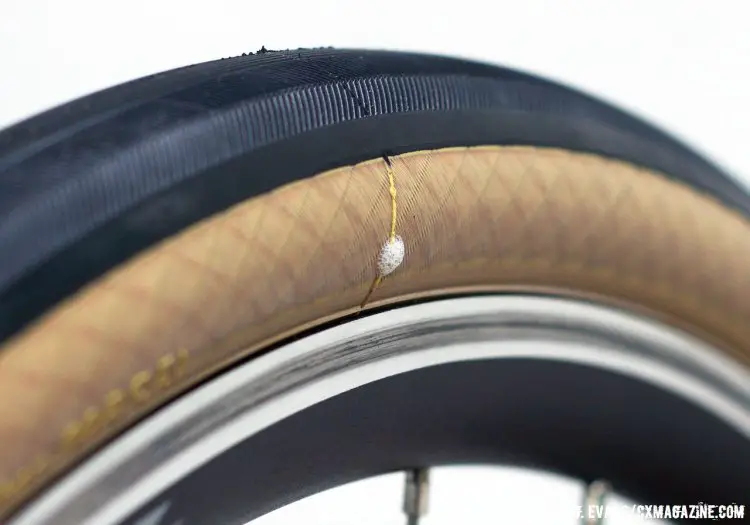
The Compass Bon Jon Pass Extralight tires were a struggle to set up tubeless with the HED Belgium Plus rims. One tire finally sealed after heave use of soapy water, while the second tire required the replacement of the thin Stans tape with some beefy Gorilla Tape before seating would oc
I rode the Bon Jon Pass tires exclusively on the HED wheels, and despite the less-than-promising tire/rim combination, I only suffered one real burp. The incident occurred during a botched curb hop in which I landed heavily off kilter, so I can’t place all of the blame on the tires. Gravel riding typically do not include off-camber curb hops.
During the first few rides on the Compass tires I noticed that these tires were a bit different. I felt quite a bit faster on the smoother sections, granted I had swapped over from a set of WTB Nano 40c tires which are both 250 grams heavier and have a much more defined tread pattern with taller knobs. Width-wise they are actually closer than the labels suggest, as the 35c compass tires measured over 37mm on the 21mm internal width HED rims at 30 psi. I’ll note that while I felt faster on the smooth stuff, I didn’t ever feel like I had lost any compliance over the Nanos when things got bumpy.
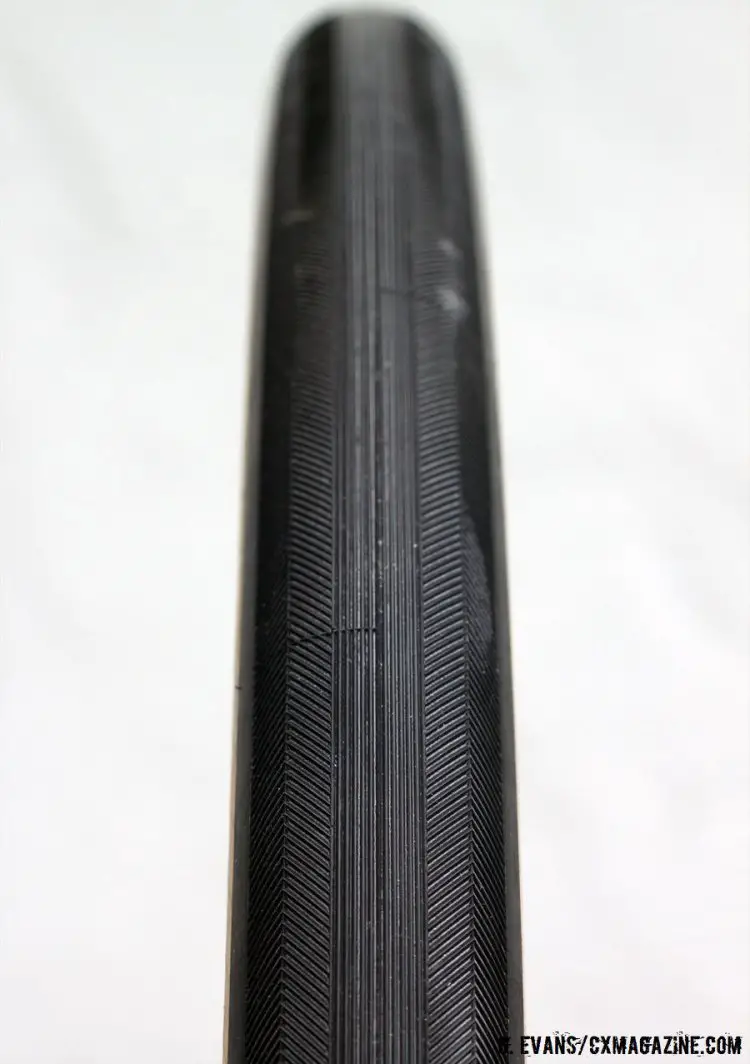
No knobs to speak of. The Bon Jon Pass features a very low profile tread pattern. Both the “Extralight” and “Standard” casing options feature the same 3mm thick tread. © Greg Evans / Cyclocross Magazine
The tires really do live up to their suppleness hype, and despite being smaller than the Nano TCS tubeless tires, I felt that they offered a more comfortable ride even when inflated to a higher pressure. Despite having virtually no tread, I rarely felt much tire slide in the corners, and it was only when things got really steep and loose or significantly off-camber that I was wishing for something with a bit more bite.
Much of this ride quality can be credited to the extremely thin tread and casing of the Extralight tire. The tires are manufactured in Japan by Panaracer from a polyester fabric casing that according to Compass “is similar to that used on the hand-made Panaracer tubulars that they make for their racing teams.” It’s not the only Panaracer-made tire that boasts tubular casing, as the Soma Fab Vitesse Tire that comes in widths from 23c to 42c makes the same claim.
The bead of the Bon Jon Pass Extralight tubeless version is made of Aramid, however that’s soon to change, Compass says, as they plan to offer an improved version that they say will be able to be run tubeless up to 90 psi. I interpret that to mean a stiffer, less stretchy bead to prevent blow-offs.
Upon asking Compass’ Jan Heine about the tpi of the tire, I was referred to an Off The Beaten Path page explaining tpi and how it relates to tire performance. In a nutshell, Heine explained to me that “the thread used for the casing compares to a 360 tpi casing from other makers, but Panaracer measures differently (only one layer, rather than all three layers as a company like Continental might count), and we used a looser weave to get a more supple tire.” He also noted that, in his opinion, measuring a tire’s performance is more dependent on the thickness of the tread, and went on to claim that “[Compass Tires] are among the very thinnest on any tire anywhere.” Heine’s comments validate some of our own testing, as seen in our Suppleness Tire Test in Issue 28 .
The Bon Jon Pass is among the first run of tubeless tires that Compass has produced, so we were immediately curious to know what made them different from the non-tubeless models. Heine started by pointing out that the tires are “tubeless-compatible” instead of “tubeless-ready.” According to Heine, the main difference between the two aforementioned classifications is that “to make them airtight would require using much more rubber on the sidewalls, which would make them much less supple.” In other words, The tires are not ready to roll right out of the box, but instead rely on the addition of sealant in order to hold air for prolonged periods of time. Heine later went on to state that the primary difference between Compass tubeless and non-tubeless offerings is that “the “tubeless-compatible” tires have a different bead shape that seals better against the rim.”
During the duration of my test, I typically ran the tires at around 35 psi with the rear sometimes pumped closer to 40 psi. This seemed like a good pressure for these tires, and I felt I could even go higher as the supple nature of the rubber seemed to elicit the same comfort of other stiffer tires when at lower pressures. The tires felt like they rolled a lot faster than they should have for a 35c tire at 35 psi.
However, after about two months of riding around at 35 psi, I began to see substantial seepage on the sidewall of the rear tire. The front tire seemed to hold up just fine, but there was far less weight positioned directly above it for the majority of the riding. It got to the point where the rear tire would lose enough pressure that I had to reinflate it each morning. For some, that’s a minor inconvenience. For others riding day-long adventures, it’s a deal breaker. (Note: We used Stan’s sealant. Compass Cycles has since told us it recommends Orange Seal sealant to seal its tires. See our update at the bottom of this review.)
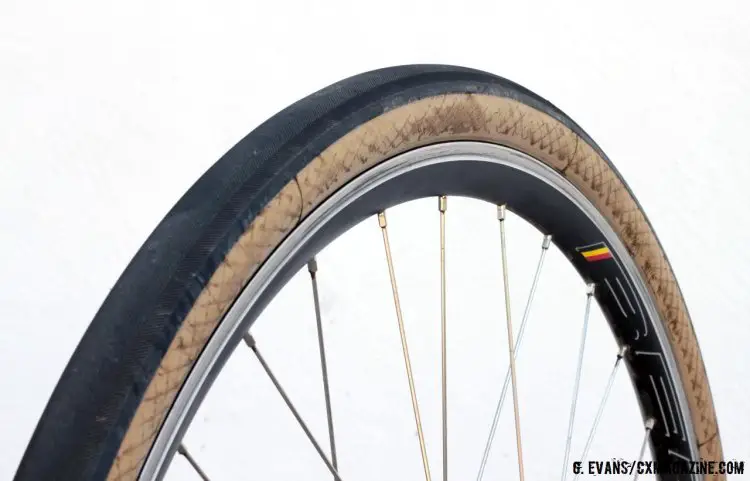
The Bon Jon Pass began to show the telltale signs of sidewall weeping as muddy crosshatching where sealant (and air) leaked appeared on the tan casing after every ride. © Cyclocross Magazine
Admittedly, my terrain of preference is typically a bit more rocky and rutted than perhaps the smooth, packed gravel roads that the tire was intended for. That being said, I don’t recall subjecting the tires to any sections of trail that presented any serious risk of sidewall damage, and as you can see in the photo, the sealant and air leaks aren’t just in one spot. I believe the premature wearing of the sidewall was a result of running too-low pressure for such a thin tire. Perhaps the “looser weave” that Heine mentioned contributes to this premature seepage as well. These tires are probably best served above the 40 psi mark to maximize durability, but for anyone purchasing these tires, using high pressure just to get a longer lasting tire seems to defeat the purpose of the purchase. Regardless, at 40psi or higher, the Stan’s Iron Cross rims would not make the safest pairing. They do still work just fine with inner tubes though.
Compass has produced a tire that is both amazingly supple and surprisingly grippy, and while the tires are a joy to ride, their durability will raise concerns for riders who like to run lower pressures or in rougher gravel. That being said, these are labeled Extralight, and there’s always a price to be paid for being a weight weenie. In this case, it’s $76 and longevity.
Compass offers the same tire with a thicker Standard casing, for less money. I’d be curious to see if the Standard tires can come close to the stellar ride quality of the Extralight while delivering the longevity that I look for in a tire. Stay tuned.
Update: Compass Cycles has not encountered any such sidewall issues before on the Bon Jon Pass Extralight tubeless tires, and has advised us on switching from Stan’s sealant to Orange Seal and riding at higher pressures to avoid “crushing” the sidewall. The company also wants to inspect the tire (after we retest it with new sealant) to investigate this issue. We’ll be testing a set of Bon Jon Pass with Standard casing, and will be trying a fresh set of Extralights to see if our sidewall issue was an isolated incident. Stay tuned.
Compass Bon Jon Pass 700×35 Extralight Tire Specs:
Options: Standard or Extralight casing
Weight: Claimed: Standard: 355 grams, Extralight: 303 grams. Actual: 291 & 307 grams (Extralight)
Width: 35mm claimed, 37.18mm measured (21mm internal width rim, at 30 psi)
Max pressure: 90 psi (with a tube)
Bead: Folding, tubeless compatible, Aramid
Casing: Polyester, 120 tpi, 360 tpi Continental equivalent
Country of Origin: Japan
Price: Standard $57 USD, Extralight $76 USD
More info: compasscycle.com























